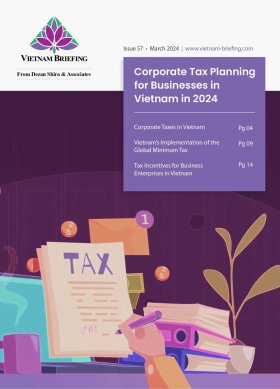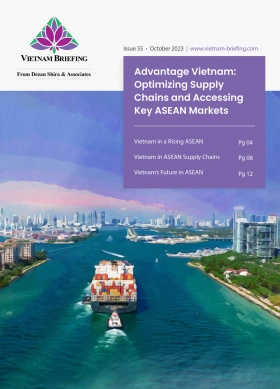Vietnam Manufacturing Tracker
The manufacturing sector is the cornerstone of Vietnam’s economic growth and resilience. The government has undertaken several initiatives to leverage the country’s inherent strengths, resulting in tangible outcomes supported by compelling data. The Vietnam Manufacturing Tracker by Vietnam Briefing offers the latest data, insights, and policy updates to keep foreign investors and analysts informed about the industry.
The second edition of The Asia Manufacturing Index by Dezan Shira & Associates is now out. The 2025 index provides essential insights into Asia’s dynamic industrial landscape, ranking eleven countries across eight categories, including tax policies, infrastructure, and innovation. Explore the rankings here.
Over the past few decades, Vietnam has effectively leveraged its key advantages to become a significant player in global supply chains, with its role gaining even more prominence amid the “China Plus One” production relocation strategy.
This growing importance is primarily driven by Vietnam’s labor-intensive manufacturing sector, characterized by relatively low labor costs, well-developed export infrastructure, and a strategic location on major trade routes.
The Vietnamese government has been proactive at both national and provincial levels, implementing measures such as national schemes, generous corporate income tax breaks for high-tech companies, and the development of specialized industrial zones.
Vietnam’s economic growth outlook
According to Vietnam’s General Statistics Office (GSO), the country’s GDP grew by 7.09 percent in 2024, despite external challenges. While this growth is slightly lower than in 2018, 2019, and 2022, it reflects a significant economic rebound.
Throughout 2024, the economy showed gradual improvement, with growth increasing from 5.98 percent in Q1 to 7.55 percent in Q4. As the new year begins, both domestic and international organizations have positive growth projections for Vietnam. HSBC forecasts the highest GDP growth in Southeast Asia for 2025 at 6.5 percent, just ahead of the Philippines at 6.4 percent.
Other organizations have even higher forecasts, with United Overseas Bank (UOB) raising its GDP projection from 6 percent to 7 percent, and the Vietnam Institute for Economic and Policy Research (VEPR) predicting growth between 7.5 and 8 percent.
For further information, see: Vietnam’s Economic Outlook for 2025: Push for Digitalization and Sustainability
GDP and the value added by the manufacturing sector
The GSO reported that the industrial sector’s value-added contribution to GDP in 2024 increased by 8.32 percent year-over-year, contributing 2.7 percentage points to the economy’s overall growth rate.
Breaking this industrial contribution down:
- Processing and manufacturing increased by 9.83 percent, contributing 2.49 percentage points;
- Water supply, management, and treatment of waste and wastewater increased by 9.43 percent, contributing 0.06 percentage points;
- Electricity production and distribution increased by 10.05 percent, contributing 0.37 percentage points; and
- Mining activity decreased by 7.87 percent, reducing growth by 0.21 percentage points.
|
Year |
GDP (US$ Billion) |
Manufacturing Output (US$ Billion) |
Manufacturing Value Added (% of GDP) |
|
2017 |
277.07 |
63.66 |
22.63 |
|
2018 |
304.47 |
72.46 |
23.37 |
|
2019 |
331.82 |
79.53 |
23.79 |
|
2020 |
346.31 |
83 |
23.95 |
|
2021 |
370.08 |
89.64 |
24.46 |
|
2022 |
407.97 |
100.86 |
24.58 |
|
2023 |
433.7 |
102.63 |
23.88 |
| 2024 |
476.3 |
|
|
|
Source: IMF/World Bank |
|||
Vietnam Manufacturing Purchasing Managers’ Index (PMI)
The S&P Global Manufacturing PMI reflects the manufacturing sector’s performance by surveying 400 firms in the industry. The PMI is built on five weighted sub-indexes:
- New orders (30 percent)
- Output (25 percent)
- Employment (20 percent)
- Suppliers’ delivery times (15 percent)
- Stock of items purchased (10 percent)
A reading above 50 indicates an expansion of the manufacturing sector compared to the previous month, below 50 represents a contraction, while 50 indicates no change.
Vietnam’s monthly manufacturing PMI data – 2024-25
|
Month |
Vietnam Manufacturing PMI (% Points) |
|
January 2024 |
50.3 |
|
February 2024 |
50.4 |
|
March 2024 |
49.9 |
|
April 2024 |
50.3 |
|
May 2024 |
50.3 |
|
June 2024 |
54.7 |
|
July 2024 |
54.7 |
|
August 2024 |
52.4 |
|
September 2024 |
47.3 |
|
October 2024 |
51.2 |
|
November 2024 |
50.8 |
| December 2024 |
49.8 |
|
Source: S&P Global |
|
Interpreting the PMI scores
Vietnam’s PMI fell below 50 for the first time in three months to 49.8 in December 2024 from 50.8 in November 2024. The scores suggest a slight dampening of business sentiment at the end of the year.
Key highlights from Vietnam’s PMI in December 2024:
- Slowdown in growth in output and new orders;
- Business confidence declines sharply; and
- Employment decline.
Vietnam’s manufacturing sector lost momentum in December 2024, with slower growth in output and new orders, alongside job cuts and reduced inventories. However, purchasing activity showed signs of recovery. Business confidence, however, fell to a 19-month low, and inflationary pressures intensified, with both input costs and output prices rising at their fastest pace since July 2024.
Andrew Harker, Chief Economist at S&P Global Market Intelligence, described these results as a disappointing conclusion to the year for Vietnam’s manufacturing sector. “This downturn was partly driven by uncertainty surrounding the incoming U.S. administration’s tariff policies. Further updates on this issue in the new year will provide more clarity on its potential impact on Vietnam’s manufacturers,” Harker remarked.
Index of Industrial Production (IIP)
The IIP is an indicator that evaluates the growth rate of industrial production monthly, quarterly, or yearly. It reflects industrial production growth in general and the growth rate of each commodity in particular.
The IIP is calculated as a percentage of the industrial production generated in the current and base periods.
Vietnam’s IIP data – 2024-25
|
Index of Industrial Production |
Monthly Growth Rate (%) |
Yearly Growth Rate (%) |
|
January 2024 |
-4.4 |
18.3 |
|
February 2024 |
18 |
6.8 |
|
March 2024 |
20 |
4.1 |
|
April 2024 |
0.8 |
6.3 |
|
May 2024 |
3.9 |
8.9 |
|
June 2024 |
0.7 |
10.9 |
|
July 2024 |
0.7 |
11.2 |
|
August 2024 |
2 |
9.5 |
|
September 2024 |
-0.19 |
10.8 |
|
October 2024 |
4 |
7 |
|
November 2024 |
2.3 |
8.9 |
| December 2024 |
0.8 |
8.8 |
|
Source: General Statistics Office of Vietnam |
||
Interpreting the IIP scores
Vietnam’s industrial sector experienced significant growth in 2024, with IIP increasing by 8.4 percent compared to the previous year. This marks the highest growth rate in the past four years, according to the GSO. The IIP growth exceeded the annual target, which was set at 7-8 percent.
Sector-specific performance of Vietnam’s IIP in 2024 is as follows:
- Manufacturing and processing industry increased by 9.6 percent, compared to 1.5 percent in 2023.
- Electricity, gas, steam, and air conditioning supply rose by 9.5 percent.
- Water supply, sewage, waste management, and remediation grew by 9.7.
- Mining and quarrying decreased by 6.5 percent.
Employment in manufacturing
Affordable labor costs are a key advantage for Vietnam in attracting foreign manufacturers. Given the manufacturing sector’s critical role in the economy, its employment impact is also substantial. By 2023, the manufacturing sector employed the second-largest workforce in Vietnam, second only to agriculture.
In the third quarter of 2024, workforce solutions firm Adecco reported a significant 35 percent year-on-year increase and a 52 percent quarter-on-quarter increase in job orders for Vietnam’s manufacturing and sourcing sectors.
|
Vietnam Employment in the Manufacturing Sector |
||
|
Year |
Total (million) |
Contribution to total employment in Vietnam (%) |
|
2017 |
9.54 |
17.8 |
|
2018 |
10 |
18.4 |
|
2019 |
11.29 |
20.7 |
|
2020 |
11.3 |
21.1 |
|
2021 |
11.21 |
22.8 |
|
2022 |
11.77 |
23.3 |
|
Preliminary 2023 |
11.96 |
23.3 |
|
Source: General Statistics Office |
||
Note: (*) Data from 2021-2023 was calculated following the ICLS19 standard. Under ICLS19, people working to produce self-sufficient products in the agriculture, forestry, and fishery sectors will not be identified as employed as per the ICLS13 standard.
Foreign direct investment in Vietnam’s processing and manufacturing industry
Vietnam’s foreign direct investment (FDI) disbursement reached a record high of approximately US$25.35 billion in 2024, marking a 9.4 percent increase. Although total FDI commitments slightly decreased by 3 percent to US$38.23 billion, positive trends emerged with 3,375 new projects approved worth US$19.7 billion.
FDI inflows targeted 18 of Vietnam’s 21 economic sectors, with manufacturing and processing leading at US$25.58 billion, followed by real estate at US$6.31 billion. The Foreign Investment Agency noted that while total registered FDI declined, there was a significant increase in capital for existing projects (50.4 percent) and new projects (1.8 percent), reflecting strong investor confidence.
The FDI sector was crucial for Vietnam’s exports, generating around US$290.8 billion and accounting for 71.8 percent of the total, contributing to a trade surplus of nearly US$49.2 billion. By the end of 2024, Vietnam had attracted a cumulative US$502.8 billion in FDI, predominantly in manufacturing and processing, which totaled US$308.76 billion.
|
Tracking FDI into Vietnam’s Manufacturing and Processing Industry |
||||||
|
Year |
Number of new projects |
Newly registered capital (US$ million) |
Adjusted project number |
Adjusted capital (US$ million) |
Number of times of capital contribution to buy shares |
Value of capital contribution, share purchase |
|
2015 |
955 |
8,927.8 |
517 |
6,305.4 |
– |
– |
|
2016 |
1,020 |
9,812.57 |
861 |
5,132.55 |
290 |
593.51 |
|
2017 |
932 |
6,860.36 |
761 |
7,271.27 |
1,365 |
1,744.36 |
|
2018 |
1,065 |
9,067.46 |
743 |
5,093.78 |
1,528 |
2,426.80 |
|
2019 |
1,314 |
12,093.14 |
861 |
5,381.98 |
2,261 |
7,086.66 |
|
2020 |
800 |
7,190.77 |
680 |
4,593.86 |
1,268 |
1,816.46 |
|
2021 |
533 |
7,251.98 |
612 |
7,346.30 |
650 |
3,522.60 |
|
2022 |
511 |
7,213 |
644 |
7,977.90 |
471 |
1,611.06 |
|
2023 |
3,188 |
20,190 |
1,262 |
7,880 |
3,451 |
8,500 |
|
2024 |
3,375 |
19,730 |
1,539 |
13,960 |
3,502 |
4,540 |
|
Source: Open Development Vietnam/MPI |
||||||
Vietnam’s merchandise exports
According to the GSO, Vietnam’s total export turnover in 2024 is expected to show positive growth despite numerous risks and uncertainties in the global economy. Preliminary reports indicate that the export turnover of goods for 2024 will reach approximately US$405.53 billion, representing a 14.3 percent increase compared to the previous year.
Of this total:
- The domestic economic sector is projected to achieve an export turnover of US$114.59 billion, which is a 19.8 percent increase, accounting for 28.3 percent of the overall export turnover.
- The foreign-invested sector, including crude oil, is anticipated to reach US$290.94 billion, reflecting a 12.3 percent increase, making up 71.7 percent of the total exports.
In 2024, there were 37 items with export turnover of over US$1 billion, accounting for 94.3 percent of total export turnover (with 8 items exported at turnover value of over US$10 billion, accounting for 69.0 percent). Electronics, computers, and components continue to be the leading export goods in terms of export value, dominated by Samsung, LG, Apple and electronic components manufacturing companies in Vietnam.
Some highlights of Vietnam’s key export merchandise in 2024 are as follows:
- Electronics, computers, and components: Export value reached US$72.6 billion in 2024, an increase of 26.6 percent compared to 2023. This category accounted for 17.9 percent of the total export turnover.
- Phones and components: Ranked second with an export turnover of US$53.9 billion, representing a growth of 2.9 percent.
- Machinery, equipment, tools, and spare parts: Exports totaled US$52.3 billion, reflecting a 21 percent increase.
- Textiles: This category generated US$37 billion in exports, up by 11.2 percent.
- Footwear: Export value reached US$22.9 billion, marking an increase of 13 percent.
- Wood and wood products: Exports amounted to US$16.3 billion, showing a growth of 20.9 percent.
- Means of transport and spare parts: This sector reached US$15.1 billion in exports, up by 6.4 percent.
|
Vietnam’s Merchandise Exports by Manufacturing Sector |
||
|
Year |
Total merchandise exports (US$ billion) |
Share of manufacturing sector (US$ billion) |
|
2017 |
215.12 |
201.65 |
|
2018 |
243.7 |
230.76 |
|
2019 |
264.27 |
252.43 |
|
2020 |
282.63 |
271.04 |
|
2021 |
336.17 |
323.59 |
|
2022 |
371.72 |
362 |
|
Preliminary 2023 |
354.72 |
328.14 |
|
Source: General Statistics Office |
||
Incentives for investing in Vietnam
Vietnam’s Law on Investment specifies the three forms of incentives that are available to companies operating within the country:
- Corporate income tax (CIT) incentives, including various preferential tax rates and tax holiday rates;
- Import duty incentives; and
- Exemption or reduction of land rents and levies.
The CIT incentives can be granted to investments based on whether they belong to prioritized or government-encouraged sectors and/or are established in economic zones or disadvantaged locations, etc.
Read more: Tax Incentives for Foreign Enterprises in Vietnam
Industrial park classification in Vietnam
Industrial parks in Vietnam fall under three categories according to Decree No. 82/2018/ND-CP on the management of industrial parks and economic zones. These are as follows:
- Export processing zones: Industrial parks focused on manufacturing goods for export and providing services to support production for export. These zones must comply with the conditions, processes, and procedures outlined in the Decree.
- Auxiliary industrial areas: Industrial parks specializing in manufacturing auxiliary products and providing related services. Up to 60 percent of the rentable industrial land within these parks can be leased or re-leased for auxiliary industry projects.
- Eco-industrial parks: Industrial parks that emphasize cleaner production, efficient use of natural resources, and cooperation among enterprises to enhance economic, environmental, and social benefits through industrial symbiosis.
Vietnam’s national policy framework for manufacturing development
Recognizing the importance of the manufacturing sector and industrial development to the health of the overall economy, Vietnam’s government has implemented several national schemes to further promote these areas.
Strategy on exports and imports for 2011-2020, with a Vision to 2030
Former Prime Minister Nguyen Tan Dung approved the Strategy on Exports and Imports for 2011-2020, with a Vision to 2030 in his Decision 2471/QD-TTg dated December 28, 2011.
This framework outlines specific targets and implementation strategies for the manufacturing sector:
- Export orientation: Focus on developing high-tech and advanced products in the processing and manufacturing industries.
- Production and economic restructuring: Encourage and attract investment in supporting industries to meet domestic needs and integrate into the global supply chain, particularly in manufacturing mechanics, electronics, automobile components, textiles, footwear, and high technology.
Industrial Development Strategy Through 2025, with a Vision to 2035
The Industrial Development Strategy Through 2025, with a Vision Toward 2035, was approved under Decision No. 879/QD-TTg dated June 9, 2014. This strategy set specific development priorities for the following processing and manufacturing sub-sectors:
- Mechanical engineering and metallurgy;
- Chemicals;
- Agricultural, forestry, and fishery product processing; and
- Garments, textile, leather, and footwear.
National Industrial Development Policy by 2030 with a Vision to 2045
Resolution No. 23/NQ-TW, dated March 22, 2018, outlines the National Industrial Development Policy for 2030 with a Vision to 2045. The specific targets to be achieved by 2030 include:
- Industry is expected to contribute over 40 percent of GDP, with the processing and manufacturing sector accounting for around 30 percent and manufacturing alone for over 20 percent.
- The proportion of high-tech products in the processing and manufacturing sector will reach at least 45 percent.
- The industrial added value growth rate will average over 8.5 percent, with the processing and manufacturing sector growing over 10 percent annually.
- Labor productivity in the industry will grow by 7.5 percent per year.
- The Competitive Industrial Performance (CIP) Index will rank among the top three ASEAN countries.
- The proportion of labor in the industrial and service sectors will exceed 70 percent.
- Development of large-scale, multinational, and globally competitive industrial clusters and enterprises.
Socio-Economic Development Plan for 2021-2025
The government’s action plan designated in Resolution No. 99/NQ-CP implements the Socio-Economic Development Plan for the five-year period from 2021 to 2025. The action plan states its specific objectives related to the manufacturing sector, which are:
- Average GDP growth rate in this 5-year period to reach about 6.5 – 7 percent;
- Proportion of processing and manufacturing industry in GDP to reach over 25 percent;
- Digital economy to account for about 20 percent of GDP; and
- Contribution of total factor productivity (TFP) to growth to be about 45
National Green Growth Strategy for 2021-2030, Vision Towards 2050
Aiming to empower the economy through a green growth transition, Vietnam’s government issued Decision No. 1658/QD-TTg approving the National Green Growth Strategy for 2021-2030 with a Vision Towards 2050. Key goals are:
- Reducing the level of energy consumption in manufacturing, transportation, commercial, and industrial activities
- Facilitating the conditions for the development of new green manufacturing industries; and
- Encouraging the application of green technologies along with manufacturing activity management and control systems.
This article was last updated January 16, 2025.
About Us
Vietnam Briefing is published by Asia Briefing, a subsidiary of Dezan Shira & Associates. We produce material for foreign investors throughout Asia, including ASEAN, China, and India. For editorial matters, contact us here and for a complimentary subscription to our products, please click here. For assistance with investments into Vietnam, please contact us at vietnam@dezshira.com or visit us at www.dezshira.com.
Dezan Shira & Associates assists foreign investors throughout Asia from offices across the world, including in Hanoi, Ho Chi Minh City, and Da Nang. We also maintain offices or have alliance partners assisting foreign investors in China, Hong Kong SAR, Dubai (UAE), Indonesia, Singapore, Philippines, Malaysia, Thailand, Bangladesh, Italy, Germany, the United States, and Australia.
- Previous Article Vietnam’s Economic Outlook for 2025: Push for Digitalization and Sustainability
- Next Article Vietnam’s Trade Performance in 2024: How to Read the Data








